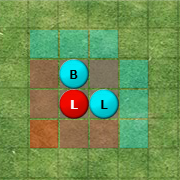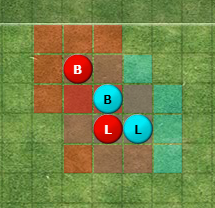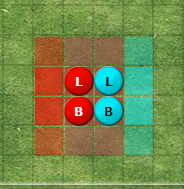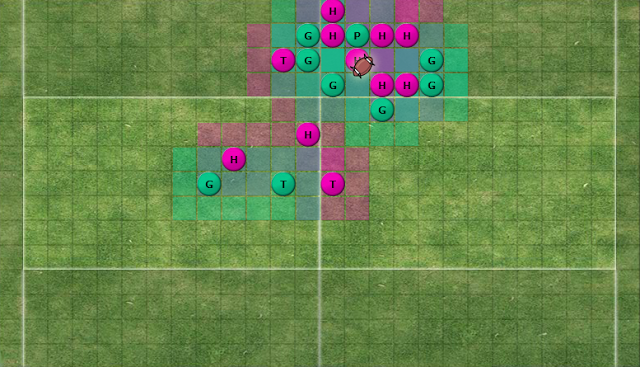Part 2: Lesson 2 - Assists, Assist Mechanics, and the Guard Skill
Newbie/Rookie/Bad Player Knowledge MegapostSo this next match is going to feature some players with Guard. Because of that, I should probably address Assists, Assist Mechanics, and how Guard works with regard to Assist mechanics properly in case it's not that clear in the video itself. Figuring out assists is something even veterans can struggle with so I'm gonna try my best to lay it out nice and simple.
I'm going to be stealing these graphics from some fuckin Wordpress blog fwiw
In the intro video, I stated that block dice are rolled based on comparing Strength scores, and that fellow players can give modifiers to that Strength check and help you beat your opponent's Strength score, as demonstrated here.

Blue L and Red L have the same Strength, so normally only a 1DB would be thrown. However, Blue B adds a +1 meaning Blue L gets to roll a 2db when they throw a punch. However, this modification works the other way around as well.

In this case, say Blue B wants to punch Red L. He gets the +1 from Blue L, but gets -1 from Red B. That's a net gain of zero and he throws a 1DB. Ok, let's try punching with Blue L, same scenario.

Blue L would love to get the +1 from Blue B, but one of the important mechanics of Assists that I didn't bring up in the intro video is that assists can only come from unmarked players. So, Red B is essentially keeping Blue B from providing an assist. How would you get yourself out of this pickle? Well, the best way would probably be to bring a third blue player to allow Blue B to get a 2db on Red B. He would choose to not follow up (assuming some sort of push or pow) and stay where he is, freeing himself to make the unmarked assist on Red L. Here's a similar gridlock situation.

No player here is giving an assist on any other player, because whenever you go to make a block, the other opponent is cancelling out your teammate's ability to provide an assist.
So, as you can see even in this isolated example, getting the assists just right can be tough, but often getting your assists right can lead to a cascading effect where a player knocks their opponent off, freeing them to assist another player who knocks their opponent off, who frees themselves to provide an assist to another player etc etc etc. Here's an example of a full match.

Just assume all players have ST 3 for simplicity's sake. This is a lot easier to look at and see the assist opportunities here than with the camera angle of a Cyanide match. It's possible to play Cyanide in this top-down, side to side view but I've just gotten so used to Cyanide camera that I don't want to change.
But anyway, pretend you're the Purple team. You can start to see where the assists are, where you would want to start in your punching, and which punches you wouldn't want to throw till you can get some assists in. Now, pretend some of those cyan players are ST4, and some of your Purple players are ST 4. Now you're getting closer to Blood Bowl thinking. Now, assume some of those opponents go down easier, and some are more difficult to knock down. Some, when knocked down, are more prone to dying than others. Some opponents can Side Step away from your punches. Some have the Guard skill, which I'll get to in a second and can ruin your Assist analysis totally. Now you're even closer to the sort of thinking you need to do as you're playing a match. This is one of the many reasons why getting good at Blood Bowl requires you to play a lot.
Now, in the upcoming match against Orks (video should be up in a couple days), there are two Orks who have the Guard skill. It's a very simple skill to describe, but can be critical in turning a brawl in your favor. A player with Guard will always provide a block modifier, even if they're marked by an opponent. So, consider this situation.

Earlier, Blue B couldn't provide an assist because he was marked. However, if he has Guard he still provides the +1 assist and Blue L can throw a 2db. Of course, if Blue B himself wanted to punch either Red player, he'd only get a 1db. Also consider this situation again.

We'll say that Blue B has guard again. If either Red L or Red B tries to punch Blue L, they would have to roll a -2db. Before it would have only been a 1db, because their ally would have cancelled out the negative modifier of Blue B. However, Guard means he provides that -1 no matter what, in addition to marking and cancelling out the +1 from either of the Red allies. If either of them tried to punch Blue B himself, though, it would still be a 1db. And, of course, if Blue L tried punching either Red B or Red L, he would get a 2db.
So, getting a Guard player in the middle of a scrum means not only are your players better off from his assist, your opponents will have a harder time punching anybody else (other than the Guard player himself). This also means your Guard player becomes the prime target in a big scrum, so he better be really buff and strong or have some good support around him, possibly in the form of even more guarding players, forming the Great Wall of Guard Dudes.
On Necromantic, Flesh Golems are tailor-made to be Guardlords, in the future. They are already ST 4 with high Armor Value, and they start with Stand Firm so they can't be pushed away from the action. If you can get a pair of Flolems with Block and Guard rooted right in the middle of the action they'll prove to be a huge headache for your opponent.
And that was another edition of Blood Bowl 101. Your homework is to go play some fuckin' Blood Bowl.
e- as always feedback and questions are welcome. It's nice to know if you guys are getting anything from these posts, because if you're not then either I need to fix them or not even bother doing them.